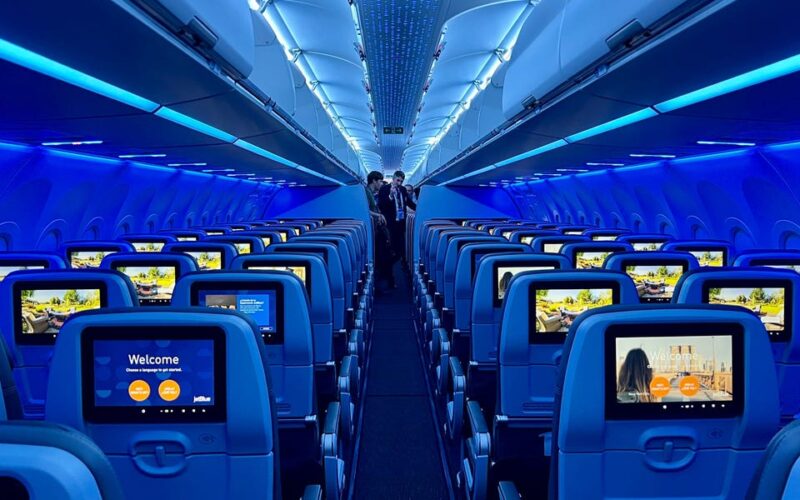- Airlines are using more narrow-body planes across the Atlantic, opening new routes for flyers.
- New single-aisle planes offer cost efficiency, smaller capacity, and flexible cabins.
- The Boeing 757 used to be the main transatlantic workhorse but is losing market share to Airbus.
New narrow-body planes designed for long-haul flights are changing how people fly.
This evolution has been largely propelled by the Airbus A321neo family, smaller planes that can flyer further than previous single-aisle aircraft. Its longest-ranged variant, the newly launched A321XLR, can fly up to 11 hours nonstop and carry up to 240 people.
These planes are popular with airlines because they can connect profitable cities that previously required a high-capacity wide-body plane like the Boeing 767 or Airbus A330. Flexible cabins mean airlines can offer different cabin configurations, like all-economy or a mix of business and coach.
Airlines can also earn extended-range allowances that govern how passenger jets can safely fly over the open ocean.
In 2024, 39,000 flights between North America and Europe are scheduled on single-aisle planes made by Boeing and Airbus, according to data from Cirium, an aviation analytics company. That’s a 14% increase from the previous year and 40% more than in 2019.
Airbus is pioneering this narrow-body shift
Such a focus on single-aisle planes that can tackle long flights has been a boon for Airbus.
JetBlue, for example, started flying between New York and Europe in 2021 with about 400 total flights on its A321neoLRs. In 2024, that figure is set to hit 7,200 in 2024.
The launch of Iberia’s A321XLR has added at least another 1,400 flights for 2025, per Cirium, with more to come as the jet is delivered to more airlines.
Such growth has come at the expense of Boeing’s 757. The jet has been a transatlantic workhorse since the 1980s but now only represents 23% of flights to and from Europe, down from 82% in 2019.
With no replacement available, airlines are turning to the A321XLR — paving the way for Airbus to continue dominating the growing market.
Long-haul narrowbodies are cheaper to fly
Before long-haul single-aisle operations became popular, airlines struggled to fly lower-demand city pairs with widebodies because the bigger planes weren’t always full — meaning they weren’t making money.
This effectively eliminated direct routes to smaller leisure markets, forcing flyers to make one or more stops to reach smaller cities.
New narrowbodies solve this problem thanks to their powerful engines, fuel efficiency, and lighter weight.
United Airlines, for example, uses single-aisle jets between unique city pairs that other carriers don’t fly, such as those from Newark Liberty to Malaga, Spain, and Chicago to Shannon, Ireland.
United’s SVP of global network planning and alliances, Patrick Quayle, told BI in August that a Boeing 787 or Boeing 767 widebody wouldn’t economic make sense in these smaller markets. The carrier plans to expand its long-haul operations with the cost-effective A321XLR.
Meanwhile, Icelandic low-cost carrier Play learned from its predecessor, WOW Air, that using widebody planes in a budget transatlantic business model is difficult because the big jet requires constant high demand — prompting Play to use Airbus narrowbodies between the US and Europe.
Single-aisle jets offer versatile route options
One reason mainline carriers like United and Iberia are moving in the single-aisle direction is because it allows them to right-size their routes depending on demand.
Cirium data shows Iberia plans to fly two A321XLRs daily between Madrid and Boston in the summer of 2025, with each carrying up to 182 people.
This allows Iberia to capture the demand without oversizing the route with two 288-passenger A330s or losing out on potential business with just one widebody.
Flying two single-aisle planes across the Atlantic instead of one widebody, for example, could up daily frequencies from one to two and give travelers more flexible options.
Airlines like Tap Air Portugal and Ireland’s Aer Lingus switch between A321neo and A330 planes throughout the year, flying the bigger jet during the summer and holiday months, per Cirium.
Single-aisle planes don’t always fly long haul. Their versatility, especially the previous generation A321neos and the Boeing 757, allows airlines to efficiently deploy them on short or medium-haul routes.
Delta Air Lines has decreased its 757 transatlantic flying over the years in favor of more domestic routes, per Cirium.
Widebodies don’t have the same flexibility, except on a few very high-demand cross-country treks like New York to Los Angeles.
Narrow-body planes can accommodate more flexible cabins
One of the draws of these small but powerful aircraft is their versatility because they can fit into both mainline and low-cost fleets with varying cabin layouts.
Some airlines, like JetBlue and Aer Lingus, equip their A321LRs with business and economy classes. Meanwhile, Hungarian low-cost airline Wizz Air plans to fly a no-frills, all-economy A321XLR cabin where even water costs extra, and France’s La Compagnie has all-business-class A321LRs.
Some flyers may be hesitant to fly on a narrow-body long-haul, but flying on these planes across the Atlantic is not much different from riding in a one cross-country.
Boston to Madrid lasts about seven hours, while New York to Los Angeles is about six and a half hours — though most flyers will get more perks on flights to Europe, like hot meals and linens.
Plus, single-aisle flying allows for quicker boarding and deplaning, which may be welcome time-savings for some customers — especially during tight layovers.
Source link
lol

